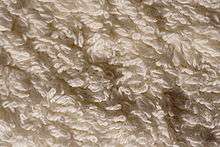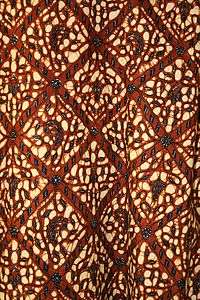Terrycloth

Terrycloth, terry cloth, terry towelling, terry, or simply towelling is a fabric with loops that can absorb large amounts of water. It can be manufactured by weaving or knitting. Towelling is woven on special looms that have two beams of longitudinal warp through which the filler or weft is fired laterally.[1][2] The first industrial production of terrycloth towels was by the English manufacturer Christy.
There are two types of terry fabrics:
- Towell Terry is a [woven] fabric with long loops that can absorb large amounts of water. Its content is usually 100% cotton, but may sometimes contain polyester.
- French Terry is a fabric, used in men's, women's and children's clothes. One of its sides is flat, while the other side is with cross loops. It is either 100% cotton or contains polyester with elastaine (lycra). It is often warp knitted, and the term French Terry is colloquially used for all warp knitted Terry.
It is the length of loops that determines how much fluid is absorbed by the cloth as longer loops provide more surface area to absorb and come in contact with the fluid.
Items that may be made from terrycloth include babies’ nappies (UK English) or reusable diapers (US English), towels, bathrobes, bedlinen, and sweatbands for the wrist or head. Terrycloth is also sometimes used to make sweat jackets. Terry towelling hats with a shallow brim were once popular with cricketers (like English wicketkeeper Jack Russell), but are no longer in fashion.
An alternative fabric used for towels is waffle fabric. A modern synthetic alternative is microfiber.
References
- ↑ "How bath towel is made - material, production process, making, history, used, composition, product, industry".
- ↑ Yilmaz, Nasire Deniz; Powell (2005). "The Technology of Terry Towel production" (PDF). Journal of Textile and Apparel, Technology and Management. North Carolina Stare University. 4 (4).
External links
![]() Media related to Terry cloth at Wikimedia Commons
Media related to Terry cloth at Wikimedia Commons


.svg.png)